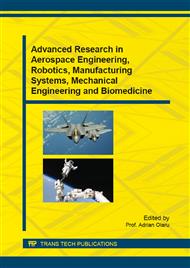[1]
M.J. Fadaee, R. Tabatabaei, Estimation of failure probability in water pipe network using statistical model, Eng. Fail. Anal. 18 (2011) 1184-1192.
DOI: 10.1016/j.engfailanal.2011.11.015
Google Scholar
[2]
X. Guo, T. Hu, X. Li, X. Zeng, X. Lei, Y. Wang, Two-dimensional reservoir operation chart with variable water allocation ratios, Journal of Hydroelectric Engineering, 6 (2013) 57-63.
Google Scholar
[3]
Q. Huang, F. Wan, L. Qiu, W.Z. Huang, Early warning system of reservoirs for water supply dispatching and its application, J. Hydraul. Eng. 10 (2011) 1161-1167.
Google Scholar
[4]
K. Pietrucha-Urbanik, Assessment model application of water supply system management in crisis situations, Global Nest J. 16(5) (2014) 893-900.
DOI: 10.30955/gnj.001414
Google Scholar
[5]
A. Wieczysty, Methods of assessing and improving the reliability of municipal water supply systems, (in Polish), Committee of Environmental Engineering Sciences, Cracow, Poland, (2001).
Google Scholar
[6]
A. Wieczysty, Reliability of urban water supply systems, (in Polish), Cracow University of Technology, Cracow, Poland, (1993).
Google Scholar
[7]
K. Knapik, R. Płoskonka R., Method of assessing the functioning of water supply systems taking into account the diversification of water tanks, Proc. Conf. Water supply, quality and water protection, Poznan-Gniezno, Poland, vol. 2, pp.493-512, (2008).
Google Scholar
[8]
S. Buchberger, Diffusion Approximation for Equilibrium Distribution of Reservoir Storage. The University of Cincinati, Ohio, USA, (1989).
Google Scholar
[9]
K. Vairavamoorthy, Y. Jimin, M.G. Harshal and D. Sunil, Gorantiwar IRA-WDS: A GIS-based risk analysis tool for water distribution systems, Environmental Modelling & Software, 7, pp.951-965, (2007).
DOI: 10.1016/j.envsoft.2006.05.027
Google Scholar
[10]
A. Estokova, V.O. Harbulakova, A. Luptakova, N. Stevulova, L. Palascakova, M. Repka, Analysis of the Selected Characteristics Changes of Cement Composites Exposed to the Sulphate Environment, Chemical Engineering Transactions, 32 (2013).
Google Scholar
[11]
M. Kwietniewski, M. Roman, H. Trębaczkiewicz-Kłoss H., Water and sewage systems reliability, (in Polish), Arkady Publisher, Warsaw, Poland, (1993).
Google Scholar
[12]
K. Pietrucha-Urbanik, Multidimensional comparative analysis of water infrastructures differentiation, eds.: A. Pawlowski, M.R. Dudzinska, L. Pawlowski, in: Environmental Engineering IV, pp.29-34, (2013).
Google Scholar
[13]
J.R. Rak, The issue of water supply diversification, Water Technology. 1 (2014) 14-16.
Google Scholar
[14]
A. Glowacz A., Diagnostics of induction motor based on analysis of acoustic signals with the application of eigenvector method and k-nearest neighbor classifier, Arch. Metall. Mater. 2 (2012) 403-407.
DOI: 10.2478/v10172-012-0039-y
Google Scholar
[15]
T. Walkowiak, J. Mazurkiewicz, Analysis of Critical Situations in Discrete Transport Systems, Proc. 4th Int. Conf. on Dependability of Computer Systems, Brunow, June 30-July 02, pp.364-371, (2009).
DOI: 10.1109/depcos-relcomex.2009.39
Google Scholar
[16]
J.R. Rak, Selected problems of water supply safety, Environ. Prot. Eng. 2 (2009) 23-28.
Google Scholar
[17]
J. Rak, A. Włoch, Models of level diversification assessment of water supply subsystem, In: Underground Infrastructure of Urban Areas, Taylor & Francis Group, London, pp.85-93, (2014).
DOI: 10.1201/b17539-25
Google Scholar
[18]
C. Shannon, W. Weaver, The Mathematical Theory of Communication, University of Illinois Press, Urbana, USA, (1962).
Google Scholar


